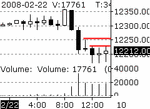dbphoenix
Guest Author
- Messages
- 6,954
- Likes
- 1,266
A springboard can be said to exist when preparations have been made for, and the psychological moment has arrived for, a quick and important move . . .
Auction markets are in continuous flow from trending states to non-trending states. If a trader is interested in movement and momentum, he will likely be interested in a trending market and try to avoid a non-trending market (what is often called "chop"). Springboards serve to alert him to upcoming changes from one state to another. They alert him to prepare for a transition (whether it turns out to be substantial or trivial) from non-trending to trending or vice-versa, i.e., that point at which price is on a "springboard" to an advance. One can busy himself with questions of who's doing what and why (weak hands, strong hands, professionals, amateurs, intent, prediction, and so on), but none of this is essential or perhaps even important. What is important is being prepared for whatever hand the market deals you. In this way, one can maintain calm and objectivity, not dither with last-minute surprises.
What one does with what is in front of him depends largely on whether he is in a trade or he is looking to enter one. If he is in a trade, he's looking for signals that momentum is slowing. If he isn't, he may be looking for the same thing as an opportunity to enter, depending on what else is going on (e.g., is support being tested, is this the end of a parabolic move, has trading activity spiked or evaporated). However, before getting into all the possible tactics that can be employed to play these movements, I suggest that whoever is interested in this subject work toward finding these zones where traders are seeking balance (or equilibrium or fair value or whatever one chooses to call it). Again, these zones occur in all charts in all timeframes. And if one understands why they form, he is less likely to be freaked when his trade stops, much less retraces (he will, of course, have decided in advance what he is going to do when this unavoidable circumstance presents itself).
To start, a chart of the DJTA over the past four years (originally posted in March ’07). It could be any instrument over any time period with any bar interval, but I'm being specific -- and using bigcharts, which is available to everyone -- so that anyone who's interested can follow along. I've also deleted the periodic volume bars and used dots rather than price bars in order to turn attention away from what is immaterial and toward the movement of price.
Without any annotations whatsoever, one ought to be able to see that price is moving in a generally upward direction with occasional "pauses":
.
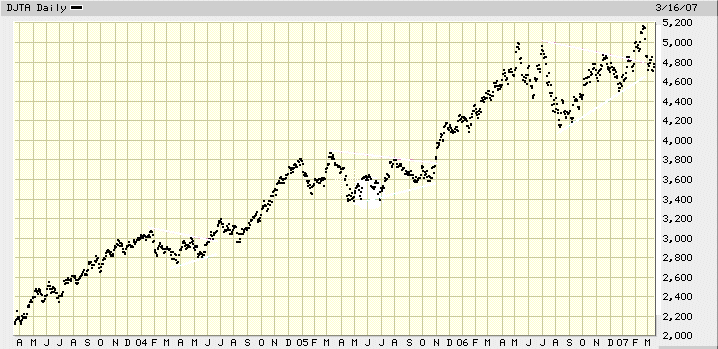
.
If annotations are necessary, the following may be helpful:
.
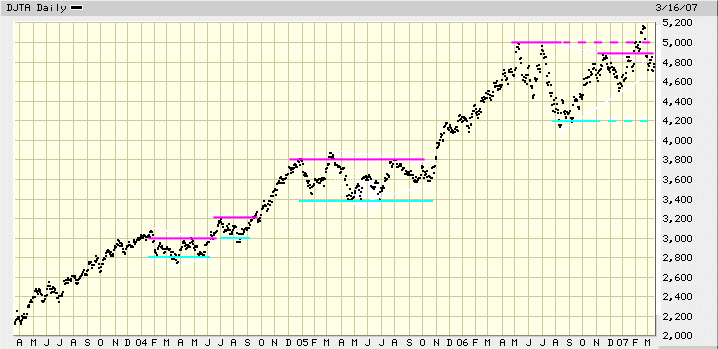
.
The exact lower (support) and upper (resistance) levels of these "zones" are not critical. What is more important in each is the general area in which the bulk of trades occur. What may also be important to the trader from a tactical standpoint is the "mean" within each of these zones toward which price will revert when bouncing around between support and resistance.
Note that each time price trends upward, it then stops or pauses in order to find equilibrium (or balance or fair value or whatever). It may engage itself in this for minutes or years, depending on time frame and bar interval. Once it has found this equilibrium, it gets comfortable. This is a "safety zone", and the bulk of trades will occur here. These pauses are not as dramatic as the trending moves because it seems as though nothing is going on. But more trades are placed at these prices than at the prices within the trending move simply because these prices are traded again and again over a period of time. This process lays the groundwork for what may become important support and resistance later (as opposed to, for example, a swing point, which, while dramatic, represents relatively few trades).
.
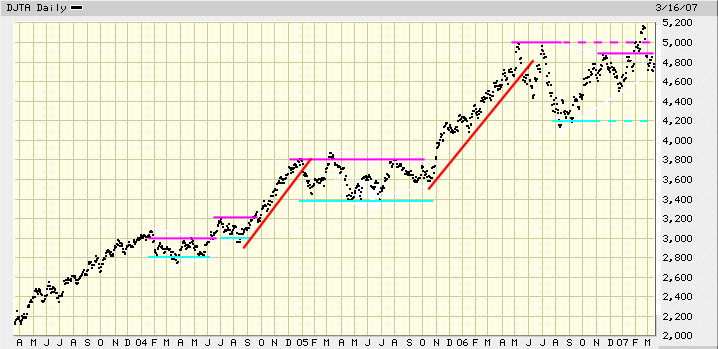
.
Eventually, there is an imbalance, or disequilibrium, and the springboard makes good its name. Price emerges from this "comfort zone" and either reverses the trend or resumes it. The emergence may be gradual, or it may be dramatic, as with a breakout. Here, in June of '04, it moves up 200pts and immediately forms a new zone. Only later, in October, does it make a more dramatic move. But that, again, reverts into yet another zone in which traders seek balance, this one lasting for 11 months.
For those who aren't scalping and who like a deliberate approach to trading, the profit opportunities will most likely be found in the reversals which occur between support and resistance in these zones and in the breakouts which occur when price's state of equilibrium is fouled and it seeks a new one. But whether one trades reversals off of S&R or breakouts through S&R, he is working the edges and avoiding the "chop". If price isn't approaching S or R, much less testing it, he's waiting, and observing, and monitoring.
Traders rejected 5000 in May ‘06, then again in July. 4200 was rejected in August and September. This is a wide range, the mean of which was 4600. Price worked the area between 4500 and 4900 for several months, again seeking equilibrium. This equilibrium was broken in February, but traders have now returned to their most recent "comfort zone". This is where they can find trades and reasonable safety. Price may remain here and find balance either side of 4800 (again, this was posted in March ’07). Or it may try again to resume the uptrend. The reversals trader who doesn't mind trading tight ranges might trade here. The breakouts/momentum trader will wait for some determined move out of the range, either up or down. But he will not likely be searching for trades in chop.
If locating these zones or pauses in which these efforts toward balance and equilibrium take place is a problem, plotting "volume by price" can help:
.
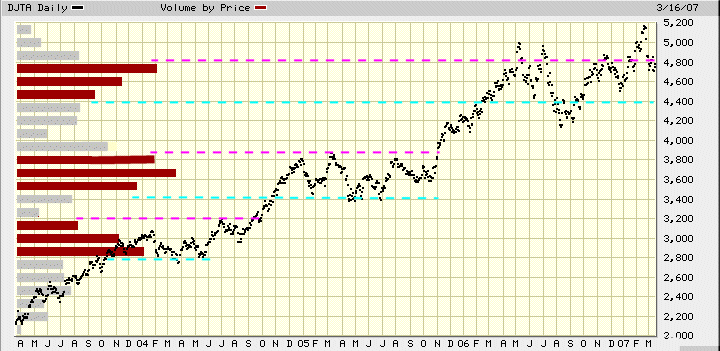
.
Note, again, that the bulk of trades are taking place within these zones. It is those areas with the fewest trades, those areas where traders are least secure, where the most potential for price movement -- often sustained price movement -- occurs. If one has no understanding of support and resistance whatsoever, much less where to locate them, this is as good a place as any to begin, and better than most.
As for hinges, these are an additional aid to spotting those areas in which traders are seeking equilibrium. They are created by successive lower highs and higher lows and represent a tightening and compression. If interest is sufficient, this compression will eventually lead to a worthwhile move (if it isn't, price may simply dribble off into nothing worth bothering with). As Schabacker later said, these hinges or coils should be "filled with price", that is, there is no aimless drift but a struggle between those who want to move price ahead and those who don't. Therefore, price should bounce in an ever-tightening range.
.
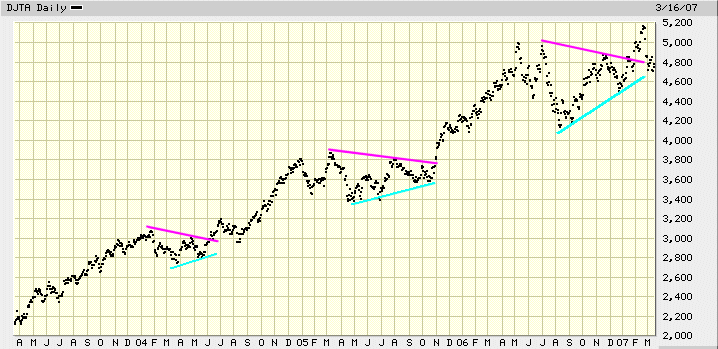
.
Some current hinges to watch:
.

Auction markets are in continuous flow from trending states to non-trending states. If a trader is interested in movement and momentum, he will likely be interested in a trending market and try to avoid a non-trending market (what is often called "chop"). Springboards serve to alert him to upcoming changes from one state to another. They alert him to prepare for a transition (whether it turns out to be substantial or trivial) from non-trending to trending or vice-versa, i.e., that point at which price is on a "springboard" to an advance. One can busy himself with questions of who's doing what and why (weak hands, strong hands, professionals, amateurs, intent, prediction, and so on), but none of this is essential or perhaps even important. What is important is being prepared for whatever hand the market deals you. In this way, one can maintain calm and objectivity, not dither with last-minute surprises.
What one does with what is in front of him depends largely on whether he is in a trade or he is looking to enter one. If he is in a trade, he's looking for signals that momentum is slowing. If he isn't, he may be looking for the same thing as an opportunity to enter, depending on what else is going on (e.g., is support being tested, is this the end of a parabolic move, has trading activity spiked or evaporated). However, before getting into all the possible tactics that can be employed to play these movements, I suggest that whoever is interested in this subject work toward finding these zones where traders are seeking balance (or equilibrium or fair value or whatever one chooses to call it). Again, these zones occur in all charts in all timeframes. And if one understands why they form, he is less likely to be freaked when his trade stops, much less retraces (he will, of course, have decided in advance what he is going to do when this unavoidable circumstance presents itself).
To start, a chart of the DJTA over the past four years (originally posted in March ’07). It could be any instrument over any time period with any bar interval, but I'm being specific -- and using bigcharts, which is available to everyone -- so that anyone who's interested can follow along. I've also deleted the periodic volume bars and used dots rather than price bars in order to turn attention away from what is immaterial and toward the movement of price.
Without any annotations whatsoever, one ought to be able to see that price is moving in a generally upward direction with occasional "pauses":
.

.
If annotations are necessary, the following may be helpful:
.

.
The exact lower (support) and upper (resistance) levels of these "zones" are not critical. What is more important in each is the general area in which the bulk of trades occur. What may also be important to the trader from a tactical standpoint is the "mean" within each of these zones toward which price will revert when bouncing around between support and resistance.
Note that each time price trends upward, it then stops or pauses in order to find equilibrium (or balance or fair value or whatever). It may engage itself in this for minutes or years, depending on time frame and bar interval. Once it has found this equilibrium, it gets comfortable. This is a "safety zone", and the bulk of trades will occur here. These pauses are not as dramatic as the trending moves because it seems as though nothing is going on. But more trades are placed at these prices than at the prices within the trending move simply because these prices are traded again and again over a period of time. This process lays the groundwork for what may become important support and resistance later (as opposed to, for example, a swing point, which, while dramatic, represents relatively few trades).
.

.
Eventually, there is an imbalance, or disequilibrium, and the springboard makes good its name. Price emerges from this "comfort zone" and either reverses the trend or resumes it. The emergence may be gradual, or it may be dramatic, as with a breakout. Here, in June of '04, it moves up 200pts and immediately forms a new zone. Only later, in October, does it make a more dramatic move. But that, again, reverts into yet another zone in which traders seek balance, this one lasting for 11 months.
For those who aren't scalping and who like a deliberate approach to trading, the profit opportunities will most likely be found in the reversals which occur between support and resistance in these zones and in the breakouts which occur when price's state of equilibrium is fouled and it seeks a new one. But whether one trades reversals off of S&R or breakouts through S&R, he is working the edges and avoiding the "chop". If price isn't approaching S or R, much less testing it, he's waiting, and observing, and monitoring.
Traders rejected 5000 in May ‘06, then again in July. 4200 was rejected in August and September. This is a wide range, the mean of which was 4600. Price worked the area between 4500 and 4900 for several months, again seeking equilibrium. This equilibrium was broken in February, but traders have now returned to their most recent "comfort zone". This is where they can find trades and reasonable safety. Price may remain here and find balance either side of 4800 (again, this was posted in March ’07). Or it may try again to resume the uptrend. The reversals trader who doesn't mind trading tight ranges might trade here. The breakouts/momentum trader will wait for some determined move out of the range, either up or down. But he will not likely be searching for trades in chop.
If locating these zones or pauses in which these efforts toward balance and equilibrium take place is a problem, plotting "volume by price" can help:
.

.
Note, again, that the bulk of trades are taking place within these zones. It is those areas with the fewest trades, those areas where traders are least secure, where the most potential for price movement -- often sustained price movement -- occurs. If one has no understanding of support and resistance whatsoever, much less where to locate them, this is as good a place as any to begin, and better than most.
As for hinges, these are an additional aid to spotting those areas in which traders are seeking equilibrium. They are created by successive lower highs and higher lows and represent a tightening and compression. If interest is sufficient, this compression will eventually lead to a worthwhile move (if it isn't, price may simply dribble off into nothing worth bothering with). As Schabacker later said, these hinges or coils should be "filled with price", that is, there is no aimless drift but a struggle between those who want to move price ahead and those who don't. Therefore, price should bounce in an ever-tightening range.
.

.
Some current hinges to watch:
.










